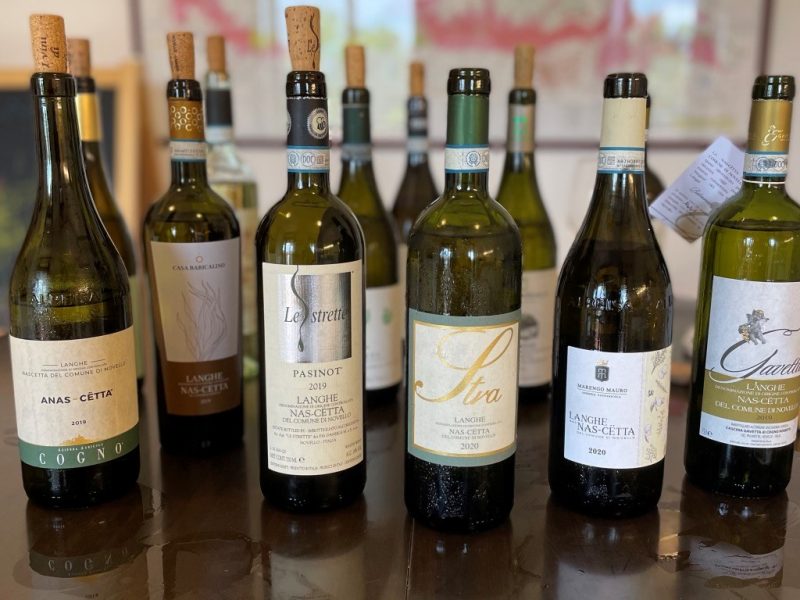
There are grapes, like Chardonnay, that are grown in seemingly every wine region around the globe. On the other extreme, Nascetta is almost exclusively linked to a single township – Novello, which happens to be one of the 11 communes that make up the region of Barolo in Italy’s Piedmont region. Here 12 wineries produce a mere 88,000 bottles from 15 hectares of Nascetta plantings.
Written documents referencing Nascetta date back to the late 1800s and these always mention the town of Novello. It was largely abandoned in the 20th century due to its limited vigour and low productivity. Phylloxera and two world wars dealt further blows.
Almost, but not quite extinct, Nascetta’s rebirth began in the early 1990s. The mayor of Novello had the sense to request that the town’s local grape be studied. At the same time, Franco Marengo opened up a bottle of 1983 Nascetta vinified in a sweet style for neighbour and renowned Barolo producer Elvio Cogno and his son-in-law Valter Fissore. “The aromas of iris, white acacia flowers and honey reminded us of Sauternes immediately and we fell in love,” recalls Fissore, who now runs the Elvio Cogno estate. The pair made their first Nascetta in 1994 – 800 bottles of a dry white crafted from just a few scattered rows.

“For a winery located in the heart of Barolo, it was challenging to start producing a white wine from an unknown grape,” continues Fissore. Nevertheless, results encouraged other wineries to follow, and the grape was officially recognized in Italy’s National Registry in 2001. The following year it was adopted into the Langhe DOC and permitted as a varietal wine.
Nascetta has expanded beyond what is thought to be its town of origin, and there are now 40 hectares of vines throughout the Langhe area. While great examples of Nascetta grown outside Novello exist, in 2010 producers within Novello were granted precious recognition. Wines that hail specifically from Novello can be labelled Nascetta del Comune di Novello. Production rules for the latter are stricter than those for Langhe DOC with lower maximum yields and 100% (as opposed to 85%) Nascetta required.
Despite such strong ties to the town of Novello, the actual origins of Nascetta are still unclear. It was once thought to come from Sardegna.
However, Italy’s foremost grape genetic researcher, Dr. Anna Schneider believes it belongs to Piedmont’s family of grapes. She explains that when a variety has such limited diffusion, it likely developed in that territory. And while Nascetta is not closely related to Nebbiolo, Savio Daniele of Le Strette thinks it could be a a distant cousin. “It has several characteristics similar to Nebbiolo,” he states. Besides being late ripening and having winged clusters like Nebbiolo, Nascetta is a tannic grape giving long-lived, complex wines according to Daniel.
It is certainly multidimensional and loaded with personality. Described as semi-aromatic, Nascetta is rich in fragrant compounds “but not as concentrated as Moscato,” says Daniele. The wines range from tropical, to stone fruit and ripe citrus though typically sport scented balsamic herbs. With age, Nascetta can become quite Riesling-like. Above all, is has a savoury edge. If you like salt, you’ll love Nascetta! This appetizing salinity is particularly pronounced in the wines from Novello, where the overall the quality of Nascetta is high.
I recently tasted through 12 wines and would happily have a glass of the following eight – especially with dinner. Whether it’s basil pesto, seafood risotto, herb roasted chicken or juicy pork chops, Nascetta can definitely stand up.
Highly Recommended
Le Strette Langhe DOC Nas-cëtta del Comune di Novello ‘Pasinot’, 2019
Brothers Savio and Mauro founded Le Strette in the early 90s and were among the early revivalists of Nascetta. Their cru Panisot bottling was launched in 2015 from the estate’s oldest plot. It demonstrates the structure and ageability of Nascetta. Still youthful, the 2019 kicks off with tropical passionfruit and pink grapefruit aromas then opens to sweet herbs. A big, ample wine, this carries its weight and alcohol marvelously. It is full-flavoured, energetic and reaches every corner of the palate. Brilliant savoury, saline finale.
Marengo Mauro Langhe DOC Nas-cëtta del Comune di Novello, 2020
Mauro Marengo’s 2020 was a coup de coeur for me. I’d never tried his Nascetta previously and it just rang of purity and a candid, humble approach that allows the grape to shine. Lively scents of pear and apricot mingle with sage, mint and rosemary. The palate is round and creamy in texture balanced by just the slightest prickle. Concentrated and sappy, it finishes long and leaves a salted pear imprint.
Cogno Anas-cëtta Langhe DOC Nas-cëtta del Comune di Novello, 2019
With the 2019, Valter Fissore has 26 harvests of Nascetta under his belt. He has tried making it with wood, then no wood; with malolactic fermentation then no MLF. And he now ages it longer in bottle before release as he believes Nascetta needs time to express itself. Even with a year or so of bottle age, this opens slowly. It is flinty and reductive at first with hints of pineapple eventually emerging. The palate is peppered with exotic herbs, candied lemon, citrus oil and a salty juxtaposition. Weighty and glycerol-like, yet fluid and peppy. If you crack this now, you might want to decant it. Fissore says a good Nascetta is at its best at five to six years old.
Reccomended
ArnaldoRivera Langhe DOC Nas-cëtta del Comune di Novello, 2019
Under the ArnaldoRivera label, the Terre del Barolo co-operative produces a new range of cru-designate Barolo as well as this Nascetta. First produced in 2016, it hails from the cru of Ravera and is aged in stainless steel for eight months on lees. A gentle intro to Nascetta, it speaks softly on the nose with hints of tropical notes intertwined with green herbs. More minerally than fruity with a steely backbone and Nascetta’s telltale salty core.
Casa Baricalino Langhe DOC Nas-cëtta del Comune di Novello, 2019
With four months of maturation in barriques, this offers Crème Brûlée and toasty aromas upfront then makes way for orange essence, oily herbs and pine. The creamy richness and weighty mouthfeel are balanced by appetizing juiciness and a distinctive chalky, sappy edge that makes you salivate.
Cascina Gavetta di Cogno Roberto Langhe DOC Nas-cëtta del Comune di Novello, 2019
Cascina Gavetta is a small family estate established by Roberto Cogno who comes from a long line of grape growers. His grandfather always cultivated a bit of Nascetta along with mainstay Nebbiolo. Here, scents of honeysuckle and herbs are somewhat reminiscent of a white Bordeaux though this is more Mediterranean in expression. The sweet-fruited palate expands with green apple jelly but remains fresh and zesty. Quite a charmer.
Luca Marenco Langhe DOC Nas-cëtta del Comune di Novello, 2019
A newcomer on the scene, Luca Marenco started his winery in 2015. This is only his second vintage of Nascetta. It is quite plump yet succulent with lots of guava flavours. Tactile and structured with lingering saltiness on finish.
Stra Langhe DOC Nas-cëtta del Comune di Novello, 2020
Three days of skin contact gives a deep golden colour and highlights Nascetta’s aroma profile. The nose is exuberant and chock-full of herbs, herb flowers and green papaya. While full, it isn’t heavy though could do with a bit more energy. Nevertheless, it is firm, assertive and refreshes the palate with a salty lick. Finishes with an intriguing, crystallized ginger nuance.
